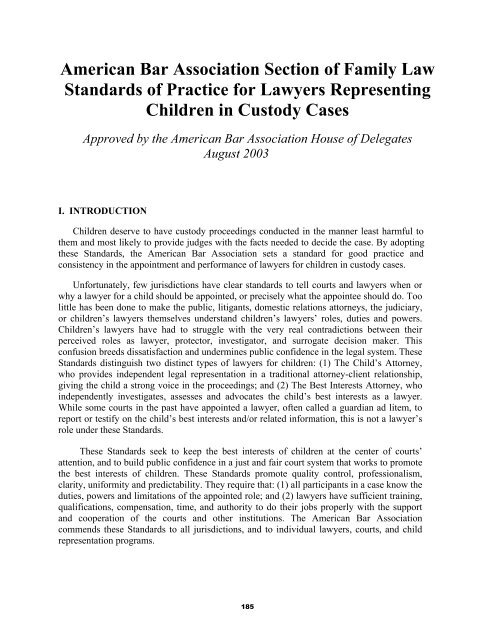A Judge’s Guide
A Judge’s Guide
A Judge’s Guide
Create successful ePaper yourself
Turn your PDF publications into a flip-book with our unique Google optimized e-Paper software.
American Bar Association Section of Family Law<br />
Standards of Practice for Lawyers Representing<br />
Children in Custody Cases<br />
Approved by the American Bar Association House of Delegates<br />
August 2003<br />
I. INTRODUCTION<br />
Children deserve to have custody proceedings conducted in the manner least harmful to<br />
them and most likely to provide judges with the facts needed to decide the case. By adopting<br />
these Standards, the American Bar Association sets a standard for good practice and<br />
consistency in the appointment and performance of lawyers for children in custody cases.<br />
Unfortunately, few jurisdictions have clear standards to tell courts and lawyers when or<br />
why a lawyer for a child should be appointed, or precisely what the appointee should do. Too<br />
little has been done to make the public, litigants, domestic relations attorneys, the judiciary,<br />
or children’s lawyers themselves understand children’s lawyers’ roles, duties and powers.<br />
Children’s lawyers have had to struggle with the very real contradictions between their<br />
perceived roles as lawyer, protector, investigator, and surrogate decision maker. This<br />
confusion breeds dissatisfaction and undermines public confidence in the legal system. These<br />
Standards distinguish two distinct types of lawyers for children: (1) The Child’s Attorney,<br />
who provides independent legal representation in a traditional attorney-client relationship,<br />
giving the child a strong voice in the proceedings; and (2) The Best Interests Attorney, who<br />
independently investigates, assesses and advocates the child’s best interests as a lawyer.<br />
While some courts in the past have appointed a lawyer, often called a guardian ad litem, to<br />
report or testify on the child’s best interests and/or related information, this is not a lawyer’s<br />
role under these Standards.<br />
These Standards seek to keep the best interests of children at the center of courts’<br />
attention, and to build public confidence in a just and fair court system that works to promote<br />
the best interests of children. These Standards promote quality control, professionalism,<br />
clarity, uniformity and predictability. They require that: (1) all participants in a case know the<br />
duties, powers and limitations of the appointed role; and (2) lawyers have sufficient training,<br />
qualifications, compensation, time, and authority to do their jobs properly with the support<br />
and cooperation of the courts and other institutions. The American Bar Association<br />
commends these Standards to all jurisdictions, and to individual lawyers, courts, and child<br />
representation programs.<br />
185


